Sibling rivalry
Getting a new puppy is exciting—at least for the humans in the family. Sometimes, however, the dog of the house doesn't think the pup is a welcome addition. Many people believe that the process of adding a puppy to the family will be harmonious and that the current dog(s) will also be excited. They are disappointed when that doesn't happen. Expectations are often unrealistic but, in most cases, what the human family members see instead of those expectations is entirely normal.
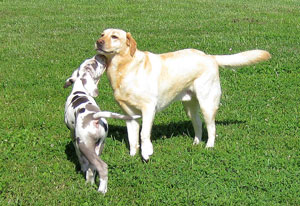
Knowing what to expect makes it as easy as possible for families to introduce a new puppy to a household with an existing dog.
What to expect
I've had the unique experience of welcoming 15 puppies into our house over the last 12 years. As puppy-raisers for a service-dog organization, my husband and I welcome a new pup each year. The new pup arrives when he is about eight weeks old. He is away from his littermates, mama, and familiar surroundings for the first time.
We have three dogs (permanent family members), and each new puppy has taught us more about how adult dogs and puppies integrate. We're working on puppy #15, and here is what we’ve learned so far:
- None of my dogs has ever welcomed a puppy with open arms (paws)
- All of the dogs growl and snap and move away from the pup
- NONE of the dogs has ever hurt a puppy
These observations are pretty normal. Every new puppy has had the same welcome from my dogs, year after year. While the occasional dog will delight in welcoming a pup into the house, in my experience, most dogs don't open up the "welcome wagon" when a new pup enters the family.
Communication skills
Puppies are just learning how to communicate. Usually, pups only have experience reading their littermates and mother. Their communication skills are still developing, and they don't know the "rules of the road" for interacting with new dogs.
Puppies even have different play styles than adult dogs. When you compare the way puppies play to the way adult dogs play, the differences are vast. Dogs follow a prescribed set of rules. There is a way to greet each other, a specific way to invite play, and a way to stop play. Most adult dogs live within a manners structure that makes their social interactions predictable and enjoyable. Dogs share a language, and adult dogs are fluent in that language.
Puppies don't follow the rules that the adult dogs depend on for good, solid doggie communication. Puppies don't even know that rules exist! When littermate puppies play together, the rule is don’t hurt one another. I've watched a gleeful puppy jump on his sleeping littermate's head. Upon waking, that littermate joyously engages in play with the head-jumper. With that kind of feedback, it is easy to see why puppies don't understand that the world has rules.
When a pup arrives at a new home and there is no other pup to play with, naturally, he picks the next closest thing: the adult dog. The pup does what he has done with his littermates—launches on the head of the sleeping adult dog. "What a rude awakening," says the sleeping dog! And the snarl that comes from the adult dog is wholly unexpected and startling to the new puppy. Occasionally, if the snarl isn't enough to deter the puppy from re-launching himself onto the sleepy dog, a full display of teeth and the most guttural growl you've ever heard will convince the pup to cease and desist.
Hear this
According to our adult dogs, puppies have abysmal social skills and have lots to learn. Our adult dogs have been valuable teachers to the puppies we have hosted, and we are grateful to them. The first lesson the puppy learns is where the lines are drawn. There are a lot of DON'Ts that our dogs teach the puppy:
- DON'T jump on my head.
- DON'T steal the toy I'm playing with
- DON'T put your face in my bowl when I'm eating.
- DON'T walk on me.
- DON'T bite my ears or my tail.
- DON'T sit on me.
- DON'T bark in my face.
- DON'T come any closer.
As long as the adult dogs' behavior is appropriate (they don't connect with the pup, for example), everything is fine, and the pup begins to learn the new house rules. After about three weeks, some play between the adult dogs and the puppy begins, although it might take four or five weeks before the adult dogs will choose to play with the pup.
Set up for success
For a harmonious household, you want to set up both the puppy and the dog for success.
Supervise!
Supervision is essential. Because the pup doesn't have the same social skills as the adult dog, I'm around for all of the interactions between the two. I want to help guide the puppy toward appropriate social efforts and keep the peace for the adult dogs. I also want my adult dogs to know I'm there running interference for them; they can count on me to keep the puppy from becoming a nuisance. The more I supervise, the fewer opportunities the dogs have to snap, bark, or growl at the pup.
Too often, we expect the adult dogs in the house to take whatever the puppy can dish out.Too often, we expect the adult dogs in the house to take whatever the puppy can dish out. That's akin to expecting restaurant diners to accept a stranger's child crawling under and climbing on their tables! Those expectations set up the puppy for trouble. The puppy won't learn the vital social skills needed to navigate his doggy world. It's also not fair for the dogs that live in your house.
Crates, gates, and pens
I like to give the puppy and the adult dogs some time apart. To separate the adult dogs from the puppy, we use tools like crates, gates, and exercise pens (x-pen) for some quiet time. Imposing periods of predictable, scheduled, and consistent separation between the puppy and the adult dogs goes a long way toward a harmonious life together. Puppies tend to be persistent and energetic. They don't give up quickly and may pester an older dog for too long. The pup and the dog get the breaks they need from each other by setting up scheduled separation opportunities.
Escape route
It's essential for both the adult dog and the puppy to have an escape route and a "safe house." I taught my dogs to move away from an annoying puppy early in our service-dog-raising years. I would call out "kennel" if my dogs were becoming annoyed by the puppy. They would run to their crates, I'd put a frozen stuffed Kongs inside, and I would close the door. The dogs could enjoy a special treat and be rid of the annoyance. Very quickly, they began self-crating when they had enough of the puppy. I reinforce the decision to self-crate almost every time with the delivery of a frozen stuffed Kong.
Avoid punishment
Growls are a form of communication. Because puppies have immature communication skills, they frequently miss the more subtle signals any older dog shows, and the dog may need to resort to growling. Resist the urge to correct your dog for growling. Growling may be what the puppy needs to recognize that the dog doesn't want to interact. If you find yourself correcting either the puppy or the adult dog, supervise more and use the crates, gates, and pens to manage the interactions between the two instead.
Reinforce the behavior you like
You can teach your adult dog to tolerate the new puppy using the same clicker training principles that are used to teach to Sit and Lie Down. If your dog ignores the puppy instead of snarling, reinforce that! Ignoring is better than snarling, right? Just like in obedience class, after your dog is ignoring reliably rather than snarling, raise the bar and reinforce the next logical step. You might reinforce something like tolerance next. Reinforce your dog for calm behavior when the puppy lies beside the adult dog. (To clarify, I don’t use a clicker for this. I may use a soft “good boy” and a scratch behind the ears, rather than a click and a treat. This helps to avoid signaling to the older dog that a formal training session has commenced.)
Click and treat
You can use the clicker to help an older dog understand that having the puppy around can be a great thing. A healthy side effect of using the clicker to ease the transition is that that pattern creates a happy association with the new puppy for the existing dog. If your older dog is active and moving about and the puppy comes to check in with you both, you could do an impromptu clicker training session. You could ask the older dog for simple behaviors like Sitting and Down. This impromptu session can help your dog associate good things (clicks and treats) with the appearance of the puppy.
What to click?
Think about what behavior you'd like to see from your adult dog that is pretty easy to accomplish. Using the example above, anything other than growling at a puppy might be a good behavior to click and treat.
I often change the criteria as the older dog gets more comfortable with the puppy and tolerates appropriate puppy interaction. I click the existing dog for voluntarily deciding to excuse himself from the situation. I would much rather that my dog simply walk away from an exuberant puppy than escalate his behavior to match the puppy.
I won't put the older dog in a position where he must resist his natural "doggie nature" and endure unpleasant puppy interactions just to earn a click and treat. I ensure that the older dog is enjoying the interaction and is patient and tolerant because he's beginning to enjoy the interaction with the pup and not just enduring it for training.
Using the clicker to reinforce appropriate behavior and limiting the pup's access to the existing dog sets up both of them for success. Manage the situation and provide clicker-trained guidance on what's appropriate for the pup and the existing dog.
Warning signs
Not every dog likes puppies. Some dogs don't tolerate puppies and may have over-the-top reactions that could harm the puppy. It's important to watch the interactions and intervene when body language and communication escalate to an unsafe level.
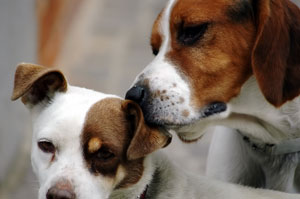
Happy together
Dogs well versed in dog-dog communication understand that a yip or squeal is the equivalent of the pup crying “Uncle!" and should back off from the pup. If you see the opposite—the cries of “Uncle" lead to increased agitation in your dog—separate the two immediately.
One big (happy) family
After what seems like an eternity but is only about three weeks, you'll notice some signs of harmony between the dog and the puppy. If you have done your part in helping the dog and puppy develop their communication skills, this is the beginning of a fabulous friendship—or at least a peaceful co-existence. Not all dogs love each other, so don't be disappointed if your adult dog doesn't fall head over heels in love with the new dog in the house. Comfortable cohabitation is a fine accomplishment.


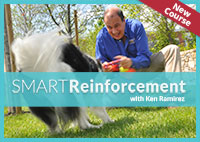

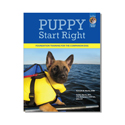
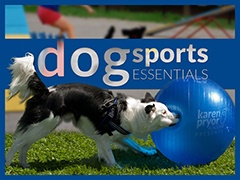
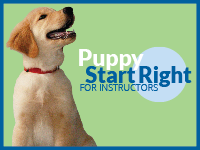

Post new comment